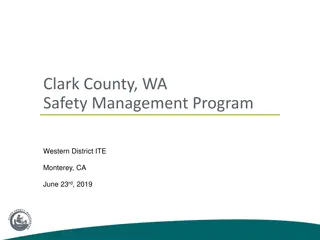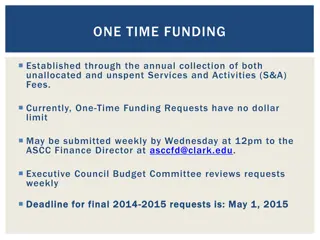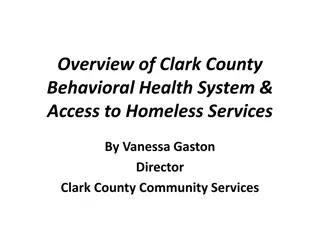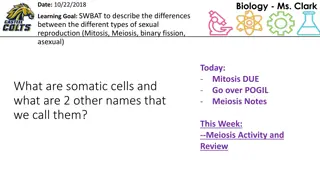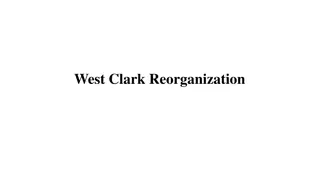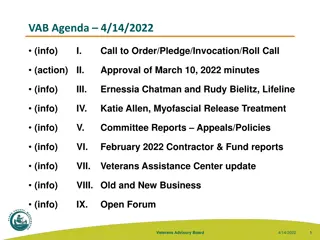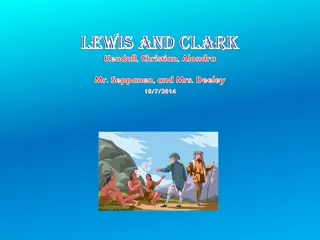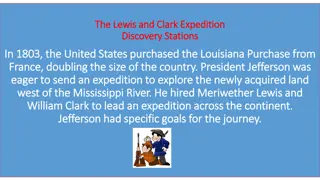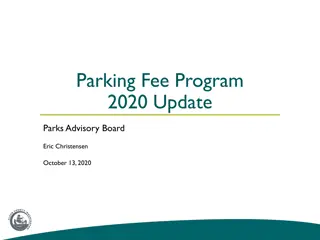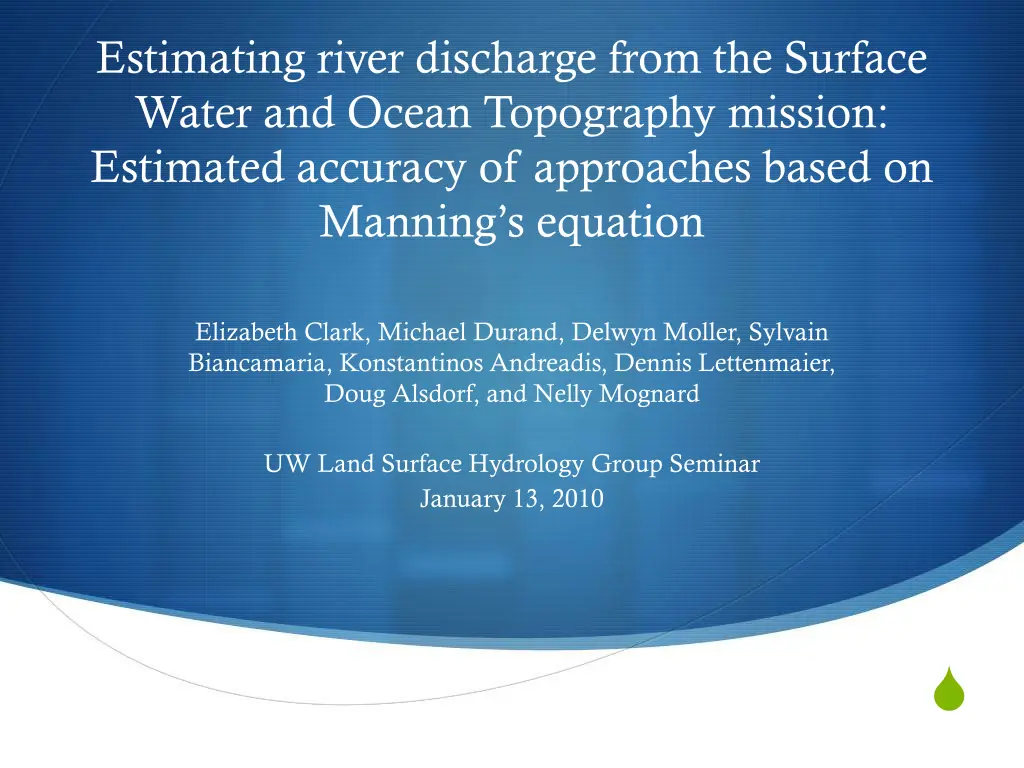
Discharge Estimation Using Manning's Equation
Explore the estimation of river discharge through the Surface Water and Ocean Topography mission using Manning's equation. Discover the accuracy of various approaches and the importance of SWOT in observing water heights. Learn about the science requirements, measurement slopes, and SWOT capabilities in estimating discharge.
Download Presentation

Please find below an Image/Link to download the presentation.
The content on the website is provided AS IS for your information and personal use only. It may not be sold, licensed, or shared on other websites without obtaining consent from the author. If you encounter any issues during the download, it is possible that the publisher has removed the file from their server.
You are allowed to download the files provided on this website for personal or commercial use, subject to the condition that they are used lawfully. All files are the property of their respective owners.
The content on the website is provided AS IS for your information and personal use only. It may not be sold, licensed, or shared on other websites without obtaining consent from the author.
E N D
Presentation Transcript
Estimating river discharge from the Surface Water and Ocean Topography mission: Estimated accuracy of approaches based on Manning s equation Elizabeth Clark, Michael Durand, Delwyn Moller, Sylvain Biancamaria, Konstantinos Andreadis, Dennis Lettenmaier, Doug Alsdorf, and Nelly Mognard UW Land Surface Hydrology Group Seminar January 13, 2010
Why do we need SWOT? Amazon There are many kinds of rivers Ohio Photos: K. Frey, B. Kiel, L. Mertes
What is SWOT? Ka-band interferometric SAR, 2 60-km swaths WSOA and SRTM heritage Produces heights and co- registered all-weather imagery Additional instruments: Conventional Jason- class altimeter for nadir AMR-class radiometer for wet-tropospheric delay corrections
Review of Existing Measurements GRACE:S independent of ground conditions, but large spatial scales Repeat Pass InSAR:dh/dt great spatial resolution, but poor temporal resolution, requires flooded vegetation Altimetry:h great height accuracy, but no dh/dx and misses too many water bodies SRTM:h and dh/dx first comprehensive global map of water surface elevations, but only one time snapshot (February 2000) The radar methods demonstrate that radar will measure h, dh/dx, dh/dt, and area. Slide: Doug Alsdorf
Science Requirements Measurement Slope Required Accuracy (1 )* 1 cm/km, over 10 km downstream distance inside river mask 10 cm, averaged over 1 km2 area within river mask 20% for all rivers at least 100 m wide WSE Area
SWOT capability to observe water height Ohio River SRTM Water elevation measurements In Situ observ- ations from Carlston, 1969; originally by Army Corps of Engineers estimated SWOT Courtesy: Michael Durand, OSU
Estimation of Discharge Manning s Equation
Estimation of Discharge Manning s Equation Assuming rectangular cross-section and width >> depth
Estimation of Discharge Manning s Equation Assuming rectangular cross-section and width >> depth In terms of SWOT observables
Estimation of Discharge Manning s Equation Assuming rectangular cross-section and width >> depth In terms of SWOT observables
First-order Uncertainties Assume that Manning s equation can be linearized using 1st order Taylor s series expansion
In situ observations Reach- averaged Value Q (m3/s) w (m) z (m) S n Mean Standard Deviation Minimum Maximum 1083 131 2.39 0.0026 0.034 9056 193 2.36 0.0052 0.046 0.01 2.9 0.10 0.000013 0.008 283170 3870 33.00 0.0418 0.664 * 1038 observations on 103 river reaches. * 401 observations have w>=100 m. * Courtesy David Bjerklie.
Depth Ideally would use a priori information For global application, possible initial depth retrieval algorithm from SWOT-based dz, S, w based on continuity assumption and kinematic assumption (Durand et al., accepted): For a test case on Cumberland River, relative depth error: mean 4.1%, standard deviation 11.2%
Depth Other possible approaches not included in analysis: Data assimilation into hydrodynamics model (Durand et al. 2008) For clear water rivers, can extract from high resolution imagery (like IKONOS; Fonstad, HAB) IKONOS image Digital Number True A Posteriori A Priori
Roughness Usually calibrated from field measurements or estimated visually in situ. Some regressions for estimating n from channel form: Riggs (1976): n=0.210w- 0.33(z0+dz)0.33s0.095 Jarrett (1984): n=0.32(z0+dz)- 0.16s0.38 Dingman and Sharma (1997): n=0.217w-0.173(z0+dz)0.094s0.156 Bjerklie et al. (2005) Model 1: n=0.139w-0.02(z0+dz)-0.073s0.15 Figure: Dingman and Sharma (1997)
Roughness Application of regression equation produces large errors in roughness, with roughly 10% mean error and 20-30% standard deviation of error. Rivers >100 m wide Relative Error in n (%) 0 J R DS B1 JDS JB1 -57% 21% 23% 24% Mean -27% -16% 9% 35% -17% 24% 8% 35% Standard deviation
Width Classification scheme nontrivial and in development at JPL Early investigations (Moller et al., 2008) show that the effect of 20 ms water coherence time on relative width errors can be reduced from ~7% averaged over a 100 m long reach to ~4% averaged over reaches between 1-2 km in length. They also found that as decorrelation approaches infinity, finite pixel sizes provide a lower bound on width bias (~10 m). Will have to screen out areas with too much layover.
Error in Q due to Errors in Slope and WSE s and dz from science requirements Relative Q error (%)
Error in Q due to Errors in Slope, WSE and z0 z0=0.112*z0 Maximum remaining variance is 0.03 Relative Q error (%)
Error in Q due to Errors in Slope, WSE, z0, and n From previous slide, the maximum relative error for either n or w, given the other is known perfectly is 17.8% Goal?: n=0.1*n. This leaves a maximum of 14.2% error for width. Relative Q error (%)
But not all errors will be their maximum and some will cancel Wanted: Probability that errors in Q will exceed 20% given the 1 errors in S, WSE, z0, n, and width Assumed uncorrelated errors and sampled normal distributions with mean 0 and standard deviation 1 for S, WSE, z0 and n. Applied a constant 10 m bias for width. Generated 1000 perturbed realizations for each river reach and computed resulting Q error statistics
Monte Carlo Results Same errors for slope, WSE and z0 (bathymetry) as previously shown, but mean Q errors near zero and standard deviation of Q errors below 20% for rivers wider than 50 m. Q/Q (%)
Monte Carlo Results Same errors for slope, WSE, z0, n (10%) as previously shown. Mean Q errors near zero. One standard deviation of Q error is greater than 20% for rivers less than 50 m wide and near 20% for those 50-500 m wide. Q/Q (%)
Monte Carlo Results Same errors for slope, WSE, z0, n (10%) as previously shown. Width bias of 10 m uniformly included. Mean Q errors higher than 20% for rivers less than 100 m wide. Q/Q (%) One standard deviation of Q error in rivers less than 500 m wide can lead to errors higher than 20%.
Dependence of Q error on z0 Q/Q (%) Previously z0 arbitrarily set to 0.5*z Q is less sensitive to errors in z0 if z0 is small Q/Q (%)
Sensitivity to higher roughness errors Normally distributed roughness errors varying from 10% (gray) to 20% (blue) Relative Q error (%) For normally distributed roughness errors ~30-40% the relative Q error standard deviation off the chart
Conclusions For the base case of Manning s equation for 1-D channel flow, discharge can be estimated with accuracies at or near 20% for most rivers wider than 100 m, assuming an improved estimation of n. Q errors are highly sensitive to errors in total water depth. Estimating depth around low flows would help to limit these errors.
Future Work Look into roughness error distribution (normal generates physically unrealistic values) Estimate and incorporate error covariances for SWOT- derived variables Explore improved algorithms for width and roughness (and bathymetry). Incorporate more spatial information.
Other Avenues Data assimilation Use in conjunction with in situ information Other satellite platforms?







